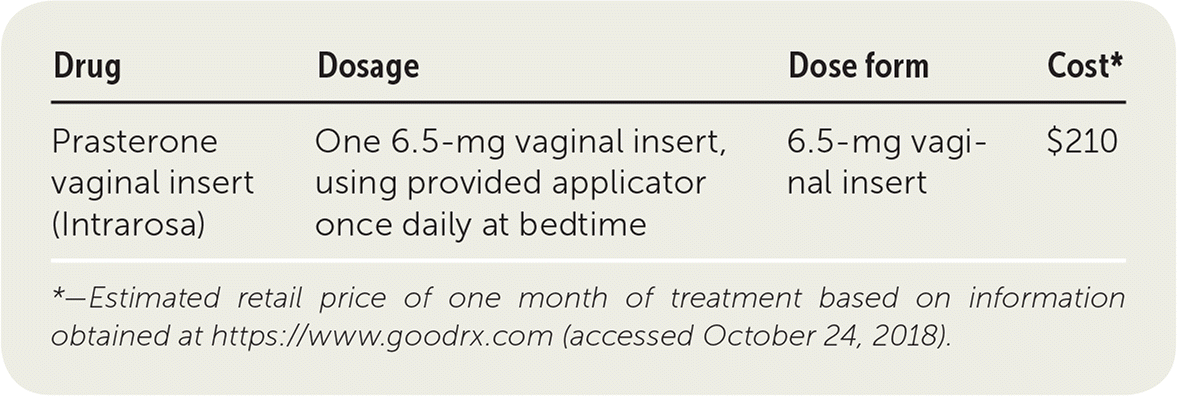
Am Fam Physician. 2019;99(2):121-122
Author disclosure: No relevant financial affiliations.

| Drug | Dosage | Dose form | Cost* |
|---|---|---|---|
| Prasterone vaginal insert (Intrarosa) | One 6.5-mg vaginal insert, using provided applicator once daily at bedtime | 6.5-mg vaginal insert | $210 |
Safety
In a 52-week noncomparative clinical trial of 530 postmenopausal women with previously normal Papanicolaou (Pap) test results, 2.1% who used intravaginal prasterone developed abnormal Pap tests at study completion. Most of these abnormalities consisted of atypical squamous cells of undetermined significance (ASCUS).1,3 These results are similar to the incidence of ASCUS in postmenopausal patients outside of this trial, but follow-up data on Pap tests in this population have not been reported. Prasterone has not been shown to increase serum steroid concentrations, nor has it been linked to the development of endometrial hyperplasia or endometrial cancer.4,5 Prasterone has not been studied in patients with a history of breast cancer, renal impairment, or hepatic impairment.1,3 It is contraindicated in women with undiagnosed abnormal genital bleeding.1 Prasterone should be prescribed only for use in postmenopausal women. It has not been evaluated for use in pregnant or lactating women.1,3
Tolerability
Effectiveness
Effectiveness has been evaluated in two clinical trials of 716 women with vaginal dryness and moderate to severe dyspareunia who reported avoiding or refraining from sexual activity because of pain (a score of 2 or 3 on a scale of 0 to 3, in which 3 is the worst pain). Using the prasterone 6.5-mg vaginal insert each evening will improve dyspareunia symptoms by 0.36 to 0.40 severity points more than an oil-based placebo at 12 weeks (P < .05 vs. placebo). The clinical significance of this difference is unclear.3,4 Individual symptoms such as vaginal dryness and vulvovaginal irritation or itching are similar in the prasterone and placebo groups.3 These results are similar to the effect of intravaginal 0.3-mg conjugated equine estrogens and intravaginal 10-mcg estradiol in decreasing the severity of dyspareunia.6 A post hoc analysis of data from one of the original clinical trials found intravaginal prasterone to improve sexual desire and sexual arousal compared with placebo, regardless of whether the patients had dyspareunia as the most severe symptom at baseline.7 A second 12-week placebo-controlled, randomized, double-blind study also examined whether intravaginal prasterone had an effect on sexual function as measured by the Female Sexual Function Index.8 This study found statistically significant improvement (2.59 points greater than placebo on a 36-point scale; P < .001) in sexual desire, arousal, orgasm, satisfaction, lubrication, and pain with sexual activity.8 The clinical significance of this difference is unclear. In general, at least a 10% difference on a symptom scale is required to demonstrate a clinically significant difference.9
Price
A 30-day supply of prasterone 6.5-mg vaginal inserts costs approximately $210. Similarly, ospemifene (Osphena) is an oral estrogen agonist/antagonist that costs about $216 for a 30-day supply. Estradiol (Vagifem) is available as a vaginal insert or an oral tablet, and a one-month supply costs about $218 or $121, respectively. Dehydroepiandrosterone (DHEA) is also available in multiple nonregulated over-the-counter preparations, although these products have not been evaluated for effectiveness.10 A one-month supply of 50-mg DHEA tablets costs about $5.
Simplicity
Prasterone is a vaginal insert in single-use applicator form. The applicators are supplied with the medication and must be disposed of after use. Prasterone should be administered once daily at bedtime. A multistep process must be followed for correct insertion, and the patient must be able to hold the applicator between her thumb and middle finger, then press the plunger with her index finger. Patients should wash their hands before and after insertion.1
Bottom Line
Prasterone is similarly effective to nonprescription options for treating vaginal dryness and itching associated with menopause and may offer a small benefit in the treatment of dyspareunia. Intravaginal prasterone may have a slight effect on increasing sexual desire and sexual arousal compared with a vaginal lubricant, but it is not labeled for this use. Prasterone may increase the likelihood of abnormal cervical Pap tests, resulting in additional testing and surveillance. After a discussion of the possible effects on Pap tests, physicians should consider prescribing prasterone as an alternative to intravaginal estrogen in patients who have not achieved satisfactory results with nonprescription lubricants.
